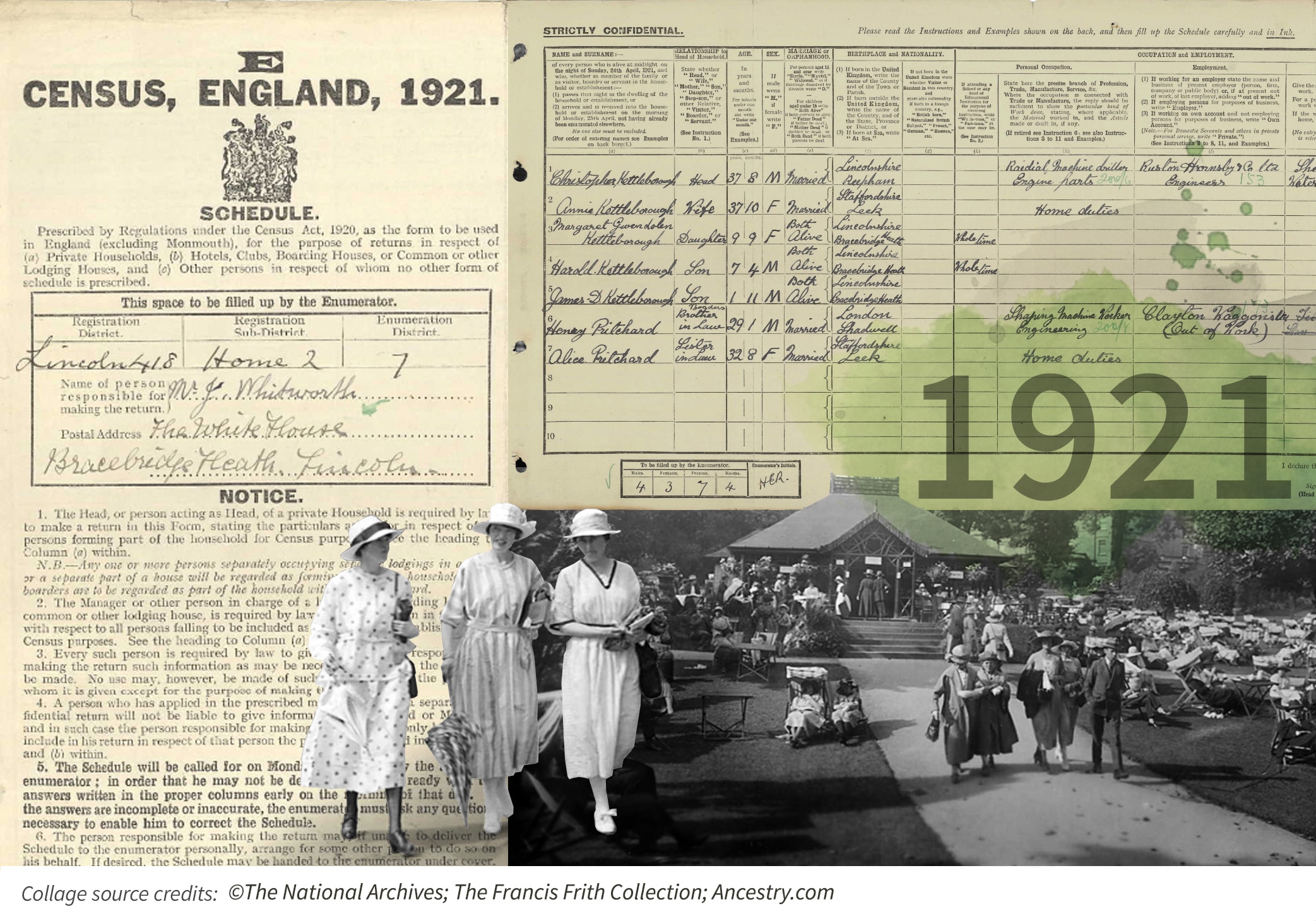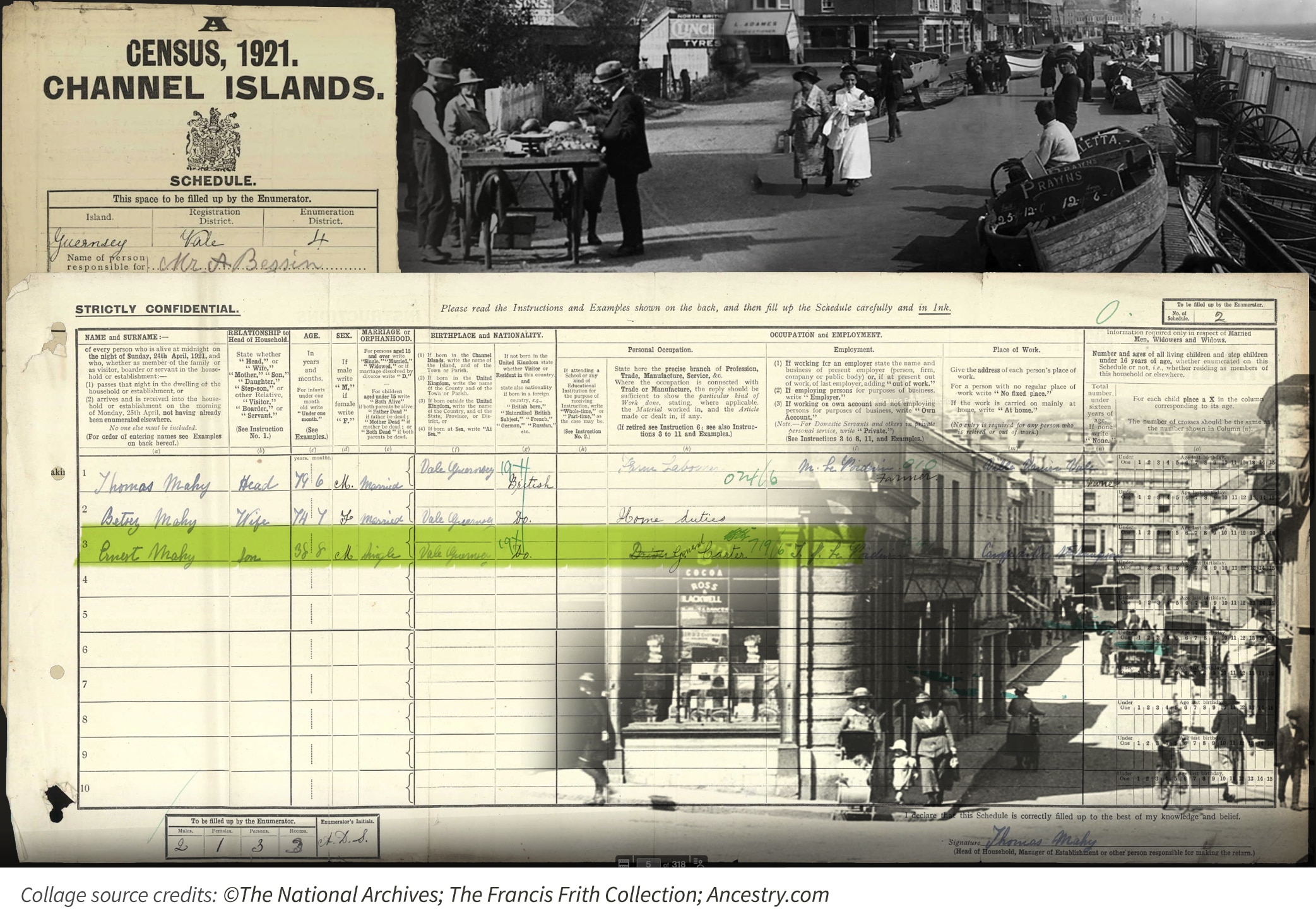Ancestry® Family History
1921 UK Census
The 1921 Census of England, Wales, the Isle of Man, and the Channel Islands offers a snapshot of life just a few years after World War I and the Spanish Flu pandemic.
For U.S.-based family history researchers whose relatives lived in Great Britain during this time, the 1921 UK Census can be a vital link between earlier British census data and subsequent appearances in U.S. census records for 1930, 1940, and 1950.
Why Is the 1921 UK Census Significant?
The census, taken on June 19, 1921, covers four major areas of Great Britain—England, Wales, the Isle of Man, and the Channel Islands—capturing details about communities in a nation still grappling with postwar recovery. People were dealing with continuing economic challenges, the lingering effects of the flu pandemic, and shifting societal roles.
The 1921 UK Census is especially important for several reasons:

• The 1931 Census for England and Wales was destroyed by fire, and no census was taken in 1941 due to World War II, which left a multi-decade gap in census data.
• Details recorded in 1921 illustrate the ongoing consequences of World War I, from war-related deaths to physical injuries and widowed spouses.
• It can suggest socioeconomic transitions that impacted individuals and families, particularly through employer details and notes on who was unemployed or searching for work.
The 1921 enumeration may also document your ancestor's last known residence in Great Britain before they immigrated to the United States.
Starting Your Research With the 1921 Census
If your British ancestors came to the United States in the 1900s before World War II, start your research with the most recently available UK census on Ancestry:
Irish census returns weren't taken in 1921 (due to the partition and other historical factors), and the 1921 returns for Scotland can be accessed separately through the National Records of Scotland (NRS).
What Can You Learn From the 1921 Census?
As with the 1920 U.S. Federal Census enumeration, the 1921 UK Census records a range of details about each individual. While the information recorded isn’t exactly the same as what’s in the U.S. 1920 Census, many facts are similar. Here’s what you’ll see noted in the 1921 UK Census:
- A person’s relationship to the head of household
- Their age, in terms of years and months as of June 19, 1921
- The place of birth for every family member
- A new marital status, “D” for “dissolved by divorce”
- The total number of living children and step-children under the age of 16, whether living with the family or not
- Occupational details, such as the person's job and industry; whether an individual worked at home on an independent basis; and for out-of-work individuals, who was their last employer
A bonus for those looking at the UK records is that the 1921 Census includes the actual signature or handwriting of the person who completed the form, which could be a family member.
Two main enhancements in the 1921 Census set it apart from earlier UK enumerations:
- Employer names and workplace addresses: You might see “Miner at Rhondda Colliery,” “Typist at Smith & Co., Cardiff,” or “Laid off—last employed at Jones Textile Mill.” These details can reveal the job market challenges and highlight whether your ancestor stayed in that occupation, left to find work elsewhere, or emigrated to the United States.
- Parental status for children under 15: The 1921 Census was the first and only enumeration to officially record whether a child's parents were still alive or deceased, and to count children who were orphans. The “orphan” term appears in earlier censuses, but there was no formal count of children with that description. In an era marked by wartime losses and a pandemic, this recording is especially poignant. A child described as having lost both parents might suggest why they moved to join relatives living in the U.S.
Be sure to review the digitized original forms of the 1921 Census records. You may discover more handwritten notations that aren’t available in the indexed version of the record.
Why Compare 1911 and 1921 UK Census Entries?
When you’re ready to research further, look at 1911 UK Census records to see how your ancestors’ lives may have changed before and after World War I and the global pandemic. Pay close attention to:
- Location changes: A teenager recorded in 1911 as helping on a family farm in rural Devon might appear in the 1921 Census working at a textile mill in Manchester, drawn by wartime factory expansions or better pay. Another relative could have left London for a quiet parish in Kent after losing a spouse, especially if they needed their in-laws' support. Learning where someone relocated may explain why they considered migrating to the United States.
- Shifts in household size: A household could have expanded between 1911 and 1921 if an older sibling returned from military service or an orphaned cousin needed a home. And one that decreased in size might reflect a death during the war or an adult child who went abroad seeking work. Tracking these changes can help you see who stayed in the United Kingdom and who might have left for new opportunities.
- Unexpected surnames: A name you don't recognize on the 1921 Census might belong to an in-law who married into the family or a newly adopted child. You could also find an orphaned relative living with a newly married woman in your line. Each surname prompts you to investigate deeper connections—some might remain in Britain, while others decide to join relatives in the U.S.
- Potential impacts of industrial action: Anyone noted as "miner, out of work" or "on strike" in 1921 may have endured hardship from the Black Friday Strike or other labor disputes, which were especially significant in coal-mining regions. A relative's unemployment record can explain why they sought opportunities overseas, perhaps encouraged by American family members who offered support or job leads.
- Expanded roles for women: Before the war, many women were listed as "at home," but by 1921, you might find your great-grandmother was employed at a local factory in Liverpool or recorded as a "clerk" with a specific employer. That shift could have stemmed from wartime labor needs or widowhood, and it might show a new sense of independence for British women that lasted beyond the war years.
- Occupational trends: The family member described in 1921 as "bus conductor" could be involved in new transport developments, while a "seamstress at Wilson Factory" might be linked to a local employer facing increased postwar demand. When you consider the context of someone’s occupation, it could lead to a broader understanding of your ancestor’s place in history.
Other UK Records and Resources to Explore
After discovering your relatives in the 1921 and 1911 Census records, consider looking at additional sources to learn more about their lives during this 10-year timespan.
- Military records: World War I service files can explain a veteran's injuries, which might clarify why a family member was marked as unfit for work in the 1921 Census. Pension files may give more details about a family who lost a husband or father in WWI.
- Newspaper articles: Articles may mention local job fairs, factory shutdowns, or a business restructuring that directly impacted your ancestor's workplace—factors that may have motivated their move to another country.
- Civil registration and parish records: Civil registration and parish records: Birth, marriage, and death indexes often confirm a key event that explains a household's changes between 1911 and 1921.
These follow-up records can turn names and ages into deeply personal narratives. For example, you could find that your second great-aunts lived together in 1921 because their parents had died. A military record might document that their father had died during the war, while a parish record could note a burial record for their mother who died during the pandemic. However, marriage announcements in the local newspaper might suggest happier futures for the sisters.

Emigration from the UK to the United States in the 1920s
When the 1921 enumeration occurred, Britain was still rebuilding after the war. High levels of unemployment among returning soldiers and wartime businesses that lost demand for their products led to significant economic instability. With severe post-war housing shortages also part of the mix, many people considered leaving for new opportunities overseas.
Did one or more of your family members make that difficult decision? See if you can track their migration to the United States by matching them to an entry on one of the UK Outward Passenger Lists or a passenger list for arrivals at New York’s Ellis Island, for example. Their entry in the 1930 U.S. Federal Census may give you the year of their arrival and whether they’ve become a naturalized citizen. By exploring other 1900s U.S. immigration documents on Ancestry, you may find their naturalization declaration or petition.
Rediscover Your British Ancestors Through the 1921 Census
Start your search today through the 1921 Census for England, Wales, the Isle of Man, and the Channel Islands. Each entry could suggest family stories of resilience or sorrow during a difficult postwar and post-pandemic period. As such, every name represents an individual who lived through an era of dramatic change, impacting whether your ancestor left Great Britain for the United States while other family members remained in their homeland.
References
-
“A land unfit for heroes? How Britain “lost” peace after the First world war.” New Histories. Accessed 29 May 2025. https://newhistories.sites.sheffield.ac.uk/volumes/2011-12/volume-3/issue-6-war-peace/a-land-unfit-for-heroes-how-britain-lost-peace-after-the-first-world-war..
“Census Records.” The National Archives. Accessed 29 May 2025. https://www.nationalarchives.gov.uk/help-with-your-research/research-guides/census-records/.
“Census unearthed: Population, widows and orphans in 1921.” Office for National Statistics.” Accessed 29 May 2025. https://www.ons.gov.uk/peoplepopulationandcommunity/populationandmigration/populationestimates/articles/censusunearthedpopulationwidowsandorphansin1921/2022-04-12.
“Council housing.” UK Parliament. Accessed 14 March 2025. https://www.parliament.uk/about/living-heritage/transformingsociety/towncountry/towns/overview/councilhousing.
“The history of transport systems in the UK.” Government Office for Science. December 2018. https://assets.publishing.service.gov.uk/media/5c07d08240f0b670656346e3/Historyoftransport.pdf.
Murphy, Kate. “Women in WWI and its aftermath – have attitudes changed?” Bournemouth University. 4 August 2014. https://news.bournemouth.ac.uk/2014/08/04/women-in-wwi-and-its-aftermath-have-attitudes-changed.
“Story of the Census.” Office for National Statistics. 20 June 2022. https://www.ons.gov.uk/visualisations/storyofthecensus/.